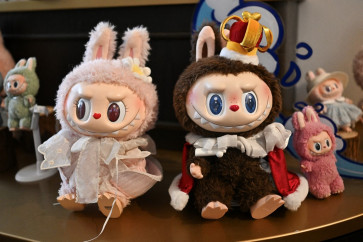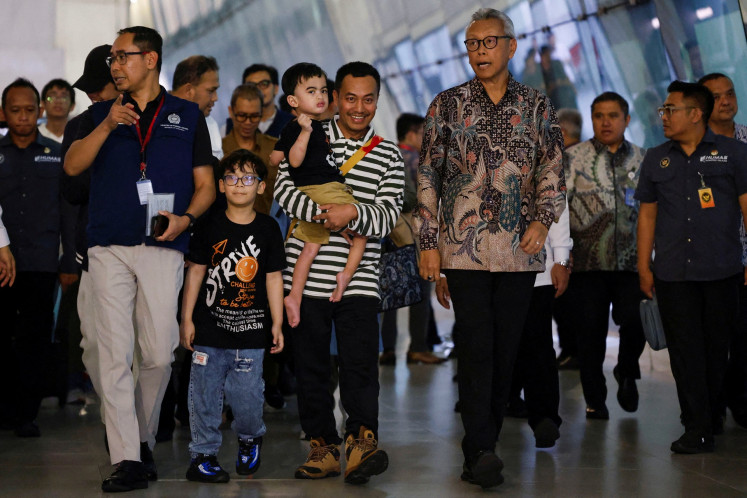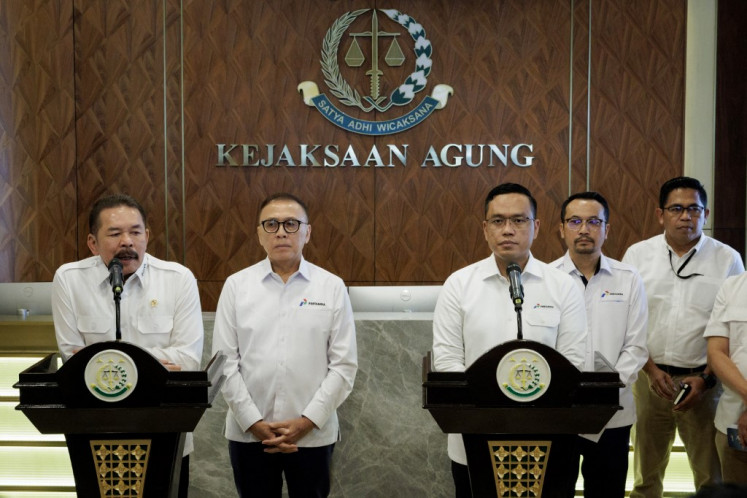Popular Reads
Top Results
Can't find what you're looking for?
View all search resultsPopular Reads
Top Results
Can't find what you're looking for?
View all search resultsThe resurrection of Gundala and the mystery in 'Enjah'
Plush toys are displayed at the PopCon Asia event at the Jakarta Convention Center on July 6
Change text size
Gift Premium Articles
to Anyone
 Plush toys are displayed at the PopCon Asia event at the Jakarta Convention Center on July 6. (JP/Nurhayati) (JP/Nurhayati)
Plush toys are displayed at the PopCon Asia event at the Jakarta Convention Center on July 6. (JP/Nurhayati) (JP/Nurhayati)
Plush toys are displayed at the PopCon Asia event at the Jakarta Convention Center on July 6. (JP/Nurhayati)
Veteran comic artist Hasmi has returned with a new issue of Gundala while today's favorite, Beng Rahadian, takes his first shot at a horror flick.
Hasmi launched the latest volume from his legendary Gundala Putera Petir (Gundala, the Son of Lightning) titled Gundala: Bangkit Dari Kematian (Gundala: Rising from Death) at the recent PopCon Asia 2013 in Jakarta.
With a revamped storyline, he hopes that the series can regain its success of the 1980s, the golden era of Indonesian comic-book artistry.
The new book centers on the return of the beloved superhero from another planet to save his friend, Nemo, who has been captured by the villain, Pengkor. Fighting a fierce battle far from Earth, Gundala tries his best for his friend.
Gundala is a superhero with the ability to use lightning as a weapon as well as having incredible speed.
Wearing a dark blue suit with matching red gloves, pants and boots, Gundala's costume is similar to that of the DC Comics' The Flash, with the difference being the wings he has on the sides of his head.
'I was actually inspired by The Flash,' Hasmi said. 'Only, instead of giving Gundala the speed of light, his top speed is only around 800 kilometers/hour and I gave him the power of lightning.'
To accompany Gundala's latest issue, a complete chronology of past Gundala stories has also been launched in a book called Banjaran Gundala.
The creator of another legendary Indonesian superhero, Laba-laba Merah (the Red Spider), Kusbram, was also at the event where he presented a new look for the superhero, whom he hopes will be revived.
He encourages everyone to come up with ideas for new storylines and to reach out to him.
Long-time fan, Surya Saputra, 40, said he had been reading Indonesian comic books, including the Gundala stories, since he was in elementary school.
'I had hundreds of Indonesian comic books. I was particularly fond of Gundala because of the familiar setting in Yogyakarta,' he said.
'Even now, amid the whole manga trend and foreign comic books, I am introducing my children to Indonesian comic books and they are also big fans. I hope one day Gundala will get the chance to face Superman, as that would make for an interesting battle or collaboration.'
Comic artists Beng Rahadian and Tomas Soejakto made a breakthrough with their collaborative work Enjah (Be Gone), a graphic novel that touches on the horror theme.
Also set in Yogyakarta, the story is about the word 'ENJAH' that suddenly appears out of nowhere on the wall of a mysteriously destroyed kitchen in a newlywed's home.
This suspenseful graphic novel will surely thrill horror fans, drawing as it does on the concept of traditional Indonesian mysticism.
The original idea and premise of this story came from Beng's colleague, Sapto 'Janang' Denaswanto, who unfortunately passed away a year into the development of the project.
Taking the ideas that were found on Janang's laptop, along with his uncle's blessing, Beng developed the project and appointed fellow comic artist Tomas Soejakto to get on board.
After overcoming many challenges during its three-year production process, the graphic novel has finally been released, adding one more title to the ubiquitous horror comic books in Indonesia.
Popular culture observer Hikmat Darmawan told The Jakarta Post that popular artworks such as comic books or graphic novels served a number of functions, including being a form of social documentation, entertainment and social commentary.
'The problem with many works in Indonesia is that people are too focused on the entertainment aspect, which results in a narrowing of meaning behind these artworks,' he said.
Hikmat said comic books should be a medium that reflected society. Local comic artists today seemed to want to compete with overseas competitors and put too much emphasis on adding 'more and more entertaining elements in their works, leaving them with less substance'.









